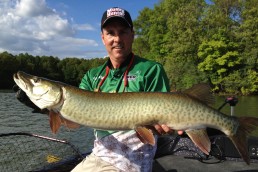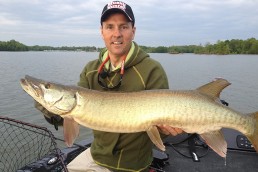SHARE THIS POST
I quietly maneuvered my boat using my electric motor through a narrow channel. I thought I saw the shadow of a muskie just ahead, but I wasn’t sure. I tossed a bass-sized minnow bait well beyond the shadow and slowly began twitching the lure back to the boat. About mid-retrieve, the lure stopped. I set the hook the best I could with monofilament line and the battle was underway. The muskie didn’t jump, but made several runs around my boat. The lighter tackle forced me to apply less pressure to the fish than with traditional muskie gear, but in short order the 38-incher was brought to the boat for a quick release.
Not a bad way to start the muskie season.
Despite making an occasional trek south, for years I’ve spent much time chasing muskies on the opening weekend throughout Wisconsin in pursuit of that first fish of the year. It’s always been a tremendous challenge, as the patterns seem to always be unpredictable from one year to the next. I remember talking with friends weeks prior to the opener trying to predict the weather and the water temperatures, only to arrive and have conditions totally different than what was anticipated. Some years the water temperatures could be in the mid-60s while other years could be mid-50s. You never know, and you can’t always predict where the muskies will be.
However, after several years of trying to second-guess these early-season fish, I decided to keep a more open mind and let the conditions come to me. Essentially, I forgot about specific cover types and focused on two things: water temperature and current. Current is always a big early-season factor. In fact, many lake chains or reservoirs will have muskies directly below a damn or a spillway. Also, current from incoming creeks or channels always seem to attract them. So, rather than worrying about cover, I began simplifying the locational aspects of finding muskies by keying in on current areas, and more importantly, areas most likely to have the warmest water. You don’t really have to even know that much about this species, at this time. However, you do need to know which types of areas will have the warmer water or current.
Channels between lakes, backwater areas, and some smaller incoming creeks may have warm water. I always look for these shallow, wind-protected areas first. You’ll often find at least a 4-degree increase in water temperature in these channel areas compared with the main-lake location. Also, depending on the water clarity and bottom content, by midafternoon there can be an even greater discrepancy in water temperatures. These little areas seem to charge up the entire ecosystem this time of year and are a major reason why the muskies are present there.
Are you enjoying this post?
You can be among the first to get the latest info on where to go, what to use and how to use it!
Other areas to look in are the wind-protected bays in the northern portions of lakes, particularly the northeast corners. The northeast corner will see the most afternoon solar heat and gets the benefit of receiving warm surface water from warmer, prevailing southwest winds. Small, shallow bays are almost always the best lake location at this time. It is amazing how shallow the muskies will be in the early season so don’t be afraid to cast to the bank, even if vegetation is growing farther from shore. These muskies are not really edge-related at this time, but instead are roaming the flats and shoreline areas.
Another thing to consider when searching for warm-water locations is the weather from the previous day. A warm southwest wind may keep areas in the northeast portion of a lake warm in the morning. However, a previous recent cold front with north winds may pull any warmer surface water from some of these same areas and they may not be as productive until later that afternoon.
Finally, the early season is a time of flux, and it seems now more than ever that muskies tend to move in and out of areas. A spot with no fish in the morning may have several in the afternoon. Just because the spot didn’t hold them earlier doesn’t mean they won’t return. If the water temperature is warmer than the other portions of the lake or is a few degrees warmer than the morning, just be ready for that spot to start holding muskies.
Sure, you can’t ignore fundamentals and you still have to be aware of the various types of shallow cover to catch these fish in the early season. But much of it comes down to water temperatures. Don’t keep pounding an area if the water temperature isn’t warmer than the rest of the lake; that alone could keep these muskies out. Even if that spot doesn’t look good now, if the water warms, be ready to fish it.
MWO
SHARE THIS POST
Did you enjoy this post?
You can be among the first to get the latest info on where to go, what to use and how to use it!
Jim Saric
Jim Saric is a Legendary Angler in the Freshwater Fishing Hall of Fame, the host and executive producer of The Musky Hunter television series, editor at large of Musky Hunter magazine, a seven-time muskie tournament winner, and a contributing writer for numerous other publications.



